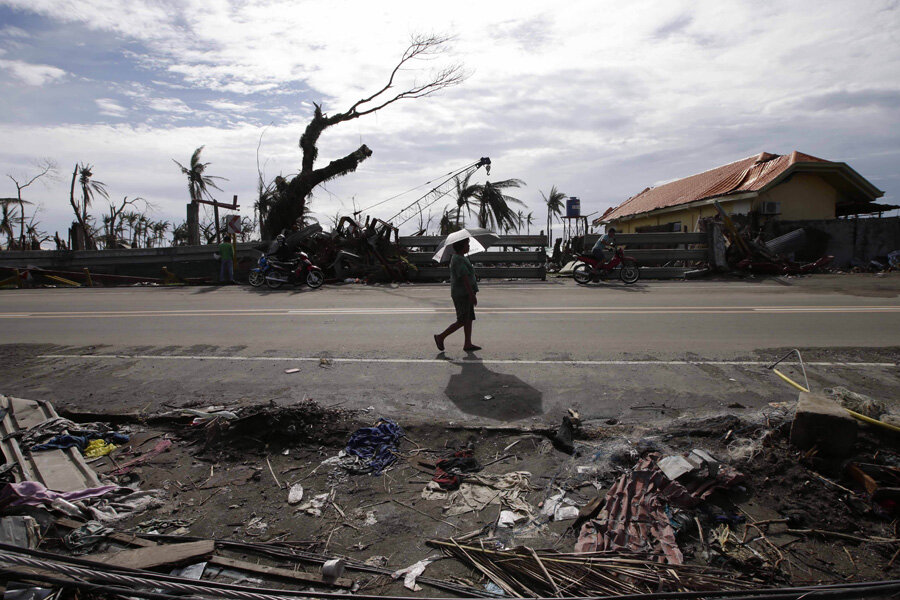Pigs, plants, or coconuts? Filipino farmers weigh trade-offs
Loading...
| GENERAL MacARTHUR, THE PHILIPPINES
Amiel Gumaniel, a pig farmer who lives on the outskirts of this coastal town, considers his latest dilemma as he surveys what’s left of his drove.
With three days worth of feed and no money left, he’s decided to sell his largest pig to a local butcher for 8,000 pesos ($184) — half the price offered to him before Typhoon Haiyan ripped through this part of Eastern Samar two weeks ago.
“The butcher knows I have no choice right now,” Mr. Gumaniel says. “We need money, even a small amount, to survive.”
Gumaniel plans to spend his earnings on more feed and as much rice as he can afford for his family. Once it runs out, he’ll go back to the butcher to sell his second largest pig, hopefully at a higher price.
Gumaniel and the other farmers in his impoverished community of 500 people in the hills above General MacArthur hope to plant rice, cassava, and sweet potatoes in a few weeks, but they need new seeds first. Those crops will be ready to harvest in four or more months. Gumaniel said coconut trees, the village’s main source of income, will take years to grow back.
The Food and Agricultural Organization (FAO) of the United Nations warned on Tuesday that hundreds of thousands of farmers in The Philippines needed urgent assistance to replant crops devastated by Typhoon Haiyan. For the thousands of small farming communities that are struggling to recover from the storm, any amount of help can’t come soon enough.
Haiyan's overall impact on The Philippine economy is expected to be relatively small. The typhoon passed by major economic centers like Manila and Cebu, largely hitting rural farmers who make up a small percentage of overall GDP. Two separate reports issued Tuesday by Credit Suisse and HBSC concluded that, for those reasons, the economic toll is likely to be short-term and limited.
For the farmers hit by Haiyan, the economic impact feels anything but small.
The Visayas region, where the typhoon landed, accounts for 12 percent of GDP, according to Credit Suisse, and is dominated by rice, sugarcane, and coconut production.
“It will take months before their lives will be back to normal,” says Edmund Sanchez, a coordinator for the Center for Agrarian Reform and Rural Development in the Central Visayas, one of the regions hit by Haiyan. “Many are worried they might go hungry while they are waiting the next harvest.”
Farming toll
The Philippine’s Department of Agriculture reported on Monday that the typhoon caused $225 million in damages to the farming industry. Rice and sugar cane fields were flooded with salt water and strewn with debris. Fishing boats were shattered and swept out to sea.
The Philippine Coconut Authority reported the typhoon severely or totally damaged more than 1.2 million coconut trees. Coconut oil was the Philippine’s top agricultural export in 2012 and the UN lists the country as the top coconut oil producer in the world.
The FAO says the affected areas account for one-third of the country's total rice production and predicted a rice shortfall of 900,000 tons for 2013. While
national rice production is likely to remain near last year’s level, the regions hit hardest by the storm could face severe food shortages if they fail to plant new crops in the coming weeks, according to the organization.
“If we want to avoid entire regions of the country having to rely on food aid, we need to act now to help vulnerable families to plant or replant by late December,” Dominique Burgeon, director of FAO's Emergency and Rehabilitation Division, said in a statement.
FAO has called for $24 million in immediate assistance for damaged fisheries and farms. The organization said it would provide farmers with seeds, tools, and fertilizer to begin replanting. It also plans to help rehabilitate storage and irrigation facilities.
“Relief operations cannot go on forever,” says Filma Calalo, an assistant agriculture professor at the University of the Philippines who specializes in rural development. “Little by little the relief will be withdrawn and long-term interventions will have to come in.”
Adora Rodriguez, a department of agriculture spokeswoman, said she was unaware of any foreign country contributing aid directly to the Philippines for farming and fishing assistance.
The department announced plans Monday to distribute additional food across the Eastern Visayas, which felt the brunt of the typhoon. It also said it would provide seeds and equipment to farmers, and more than 1,000 boats to fishermen, to help them regain their livelihoods.
Gumaniel hopes his 20 pigs and what little food he and his family receive from relief groups can hold them over until the next harvest.
“We’re starting from zero,” he says. “But we can rebuild slowly.”







